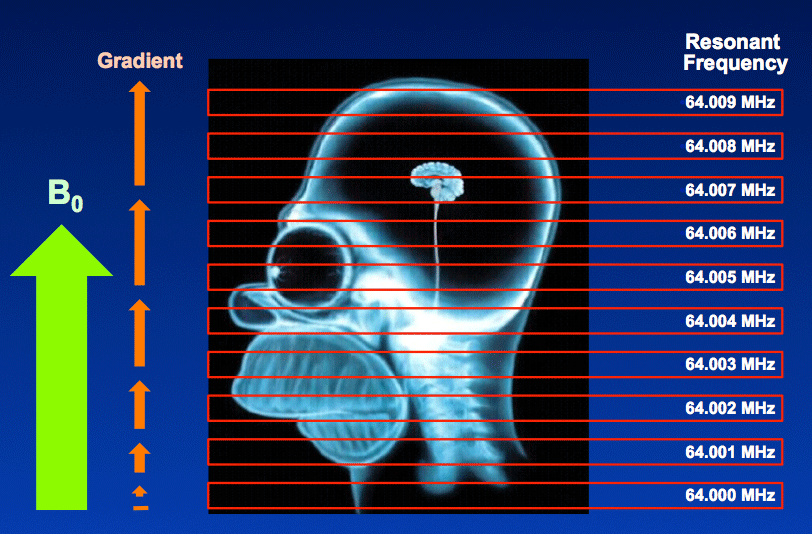Frequency-encoding of spatial position is accomplished through the use of supplemental magnetic field gradients. Gradients mildly distort the main magnetic field in a predictable pattern, causing the resonance frequency to vary as a function of position. Frequency-encoding may be used to define location either: 1) within a slice, or 2) between slices.
|
Frequency Encoding for In-Plane Localization
The figure right shows how frequency-encoding may be used to specify position within a slice. Here a frequency-encoding gradient (Gf) begins on the left of the image at position x=0 and increases linearly along the horizontal axis. If the main (static) magnetic field is Bo, then the effective field B(x) at any point (x) along the horizontal axis is given by
B(x) = Bo + xGf
From the Larmor equation (f = γB), we can easily show that the resonant frequency f(x) also varies linearly with position (x) along the frequency-encoding axis:
f(x) = γB(x) = γBo + γx•Gf = fo + fg(x)
where fo is the main field Larmor frequency and fg(x) is the frequency offset based on position along the gradient.
|
Each pixel has a finite width, so actually contains a small range of frequencies (called the per pixel bandwidth) rather than just a single frequency. Nevertheless, the signals in any column (such as ABC) have all been assigned to the same narrow band of frequencies, and these are different from the signal frequencies of another column (such as DEF).
Although frequency-encoding is a big step, we are still not able to discriminate between pixels within a column (e.g. A vs B vs C) because their frequencies overlap. Spatial detection in this second dimension will require another method, typically phase-encoding.
Frequency Encoding for Slice Selection
|
Frequency-encoding can also be used to define the position of entire slices in 2D imaging. The basic principle is the same as for within-plane frequency-encoding, but now the gradient is applied along the slice-select direction. The center resonant frequency of entire slices will now vary linearly as a function of position. A single slice may be stimulated by applying an RF-pulse tuned to specifically to the frequencies in that slice. The design of such RF-pulses and more details of slice selection are found in later Q&A's.
|
Advanced Discussion (show/hide)»
Although frequency-encoding is used to define slice position in 2D MR imaging, slice-selection in 3D MR imaging is typically performed using phase encoding.
Related Questions
How does the scanner know the locations of all the MR signals?
How does the scanner know the locations of all the MR signals?


